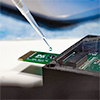| May 08, 2025 |
A breakthrough biosensor detects glucose in human tears at ultra-low concentrations, opening new avenues for wearable health monitoring technologies.
(Nanowerk News) In a significant leap toward the future of diabetes care, INL researchers have developed a graphene-based biosensor capable of detecting glucose at attomolar levels—representing the lowest detection limits ever achieved for this crucial biomarker. It’s comparable to finding a single grain of sugar dissolved in an entire lake.
|
|
The study, published in the Journal of the American Chemical Society (“Graphene-Based Glucose Sensors with an Attomolar Limit of Detection”) and led by Dr. Andrea Capasso at INL, introduces an ultra-sensitive glucose sensor based on graphene field-effect transistor (GFET) technology. Engineered to operate with extremely small volumes of biological fluid – down to a single tear -, this device has the potential to revolutionise glucose monitoring, particularly in non-invasive and wearable systems.
|
|
The researchers developed a targeted graphene functionalisation using glucose oxidase (GOx), enabling highly selective glucose recognition. They then employed advanced spectroscopic and microscopic techniques to analyse the graphene’s chemical composition and surface modifications at each stage of functionalisation, from enzyme immobilisation to interaction with the target analyte.
|
|
“While finger-prick sensors remain the clinical standard for diabetes monitoring, they are often perceived as uncomfortable and invasive,” says Dr. Capasso. “Our goal was to develop a technology capable of reading crucial physiological information without the need for blood. But it still took some tears to get there – quite literally, as I had to collect my own tears to validate the sensor’s performance with a real biological sample”.
|
 |
| (Image: INL)
|
|
The graphene-based biosensor converts subtle biochemical interactions into distinct electronic signals. When exposed to glucose, enzymatic activity generates hydrogen peroxide near the graphene channel, resulting in a measurable shift in the transistor’s Dirac point voltage. The device consistently demonstrated high signal reproducibility, a sensitivity of 10.6 mV/decade, and excellent selectivity – even in the presence of interfering compounds such as lactate and ascorbic acid.
|
|
“The ultra-low detection threshold achieved by our devices makes it possible to use less invasive media, such as tears, saliva, or sweat, where analyte concentrations are much lower than in blood and harder to detect with conventional sensors,” adds Vicente Lopes, first author of the study. “This opens up exciting possibilities for continuous monitoring and non-invasive diagnostics, where both sample volume and sensitivity are critical.”
|
|
By integrating cutting-edge materials science with biochemistry and microelectronics, the study delivers a functional, scalable biosensing platform that can be adapted to a wide range of clinically relevant targets.
|
|
“This is about much more than just breaking detection records,” concludes Capasso. “We’re building a foundation for graphene-based biosensors that can empower patients with real, actionable data – without the needles. And this progress is supported by the robust and versatile GFET platform developed over the past years by Prof. Pedro Alpuim at INL. The road ahead may still be long, but we’ve opened several paths that didn’t exist before.”
|


